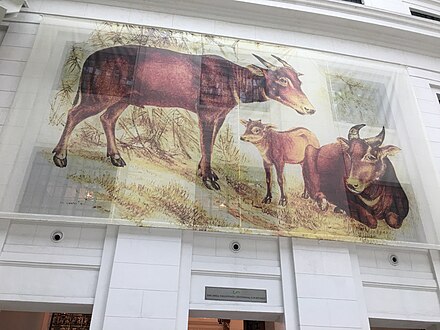Cebu Tamaraw Habitat
Cebu Panay Negros Island 19. It is endemic to the island of Luzon in the Philippines.
Tamaraw Bubalus Mindorensis Quick Facts
Inner Mindoro exploration and tamaraw habitat assessment.

Cebu tamaraw habitat. Results and outcomes are detailed in the last report. The fossil specimen is likely from the Pleistocene or the Holocene in age. Hunting for food and sustenance is another serious threat that affected the species numbers.
1 Anatomy and Morphology 2 Evolutionary history 3 Fossils of new pygmy water buffalo provide. The approximate range is depicted in the map below. The disk Its natural habitat is subtropical or tropical moist lowland surface of newly opened flowers is described to as distinctly forests.
2000 Heaney et al. It is typically found in thick brush near open-canopied glades where it may feed on grasses. Tamaraw Population Survey and Current Status E.
Cebu warty pig Negros warty pig Habitat. Since human habitation and subsequent forest fragmentation of their home island of Mindoro the habitat preferences of the tamaraw have somewhat expanded to lower-altitude grassy plains. The Tamaraw is endemic to the Philippines.
Looking different from other crocodiles Philippine crocodiles have relatively wider snouts and harder spine. This crocodile has habitat on the Mindoro islands it causes The Philippines crocodile is also referred to the Mindoro crocodile. The Tamaraw is endemic to the Philippine island of Mindoro 9735 km² in area where it was formerly widespread across the island S.
TAMARAW The wild buffalo a distant cousin of the carabao has been grazing the land 12000 years ago long before there were any natives to disturb their peace much less malls. Cebu Panay Negros Island 2. It is endangered and threatened by habitat loss.
Seems things are looking bleak for the boar as Cebu is the unofficial lechon capital of the Philippines. The Cebu tamaraw stood only 75 cm 2 ft 6 in and weighed about 150 to 160 kg 330 to 350 lb. Tamaraw inhabit areas with mixed forest and grassland.
The Cebu warty pig previously lived on the island of Cebu before becoming extinct in modern times primarily due to habitat destruction and human exploitation. Tamarw also suffer from poaching and diseases from livestock. Within their mountainous environment tamaraws will usually be found not far from sources of water.
Paleontological and archeological findings yielded information regarding the extinct mammalian species found in the Philippines through the excavation of various sites in the country. Once believed to roam the island of Luzon they can only be found in the wild in Mindoro. Thus the species still thrives in the archipelago but is locally extinct on the island of Panay.
Mindorensis prefers tropical highland forested areas. Ecological assessment of the two residing tamaraw subpopulations - core zone of the monitoring and Aruyan-Malati Tamaraw Reservation. It is said to be one of the rarest mammals in existence.
Luckily breeding programs for the specie are being undertaken in Rotterdam Zoo and San Diego Zoo. The species is endemic to the Philippine island of Mindoro where they are currently found in Mount Iglit-Baco National Park around Mount AruyanSablayan and in the Mount Calavite Tamaraw Preserve. Average diameter of 973 cm when fully expanded.
CITY OF CALAPAN ORIENTAL MINDORO Philippines The number of tamaraw Bubalus mindorensis now roaming in the mountains of Mindoro has declined to below 500 as conservationists blame human activity for the reduced population of this animal endemic to the island in Southern Tagalog. The tamaraw was originally found all over Mindoro from sea level up to the mountains 2000 meters above sea level but because of human habitation hunting and logging it is now restricted to only a few remote grassy plains and is now an endangered species. Conservation efforts are now focused on the on-site protection of wild populations at the 1600-hectare core habitat of Iglit-Baco as well as Mount Calavite Wildlife Sanctuary where a juvenile tamaraw has been sighted again in Junea first in 27 years.
The Cebu tamaraw Bubalus cebuensis is a fossil dwarf buffalo discovered in the Philippines and first described in 2006. The biggest threat to tamaraw is habitat loss due to infrastructure development logging and agriculture. Together with Tamaraw Rangers and a local guide also formerly a Tamaraw Ranger you will not only learn about the critically-endangered endemic Tamaraw and have the chance to see them in their natural habitat but you will also get to immerse with the rangers and hear the stories behind all that they do.
The size of this crocodile is quite small with a length of about 15 m and a weight of about 15 kg. The Cebu tamaraw Bubalus cebuensis is a fossil dwarf buffalo discovered in the Philippines and first described in 2006. This little piggy once thrived across the Visayas region but due to widespread hunting and habitat loss it is now only found in dense forests and grasslands of Panay and Negros islands.
It is not however our national animal. The subspecies was declared extinct in 2000.

Loading About Us Mandate And Objectives Director S Message Vision And Mission Organization Relevant Laws And Issuances Contact Us Museums And Branches National Art Gallery Museum Of The Filipino People Planetarium Regional Museums

0 komentar: